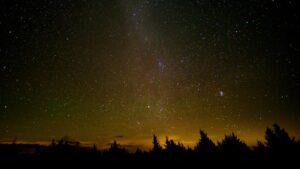October brings longer nights and crisp autumn skies, making it a perfect month for stargazing. From a glowing Super Harvest Moon to the Orionid meteor shower, plus bright planets and deep-sky treasures, here’s everything you can look forward to in the night sky this October 2025.
Moon Phases in October 2025
October kicks off with a Super Harvest Moon on the 7th. This one will look bigger and brighter than usual since the Moon is near perigee, its closest point to Earth.
Later in the month, the New Moon on October 21 gives you the darkest skies of the season – perfect for hunting down galaxies and nebulae.
- Full Moon (Super Harvest Moon) – Oct 7
- Last Quarter – Oct 13
- New Moon – Oct 21
- First Quarter – Oct 29
Major Astronomical Events
October is loaded with skywatching highlights.
Early in the month, you’ll catch the Moon passing by Saturn, Neptune, and the Pleiades star cluster.
Mid-month, the Moon teams up with Jupiter, Venus, and even Regulus in some striking pre-dawn views.
The real showstopper? The Orionid meteor shower peaks on Oct 20-21 – right next to the New Moon, so conditions couldn’t be better.
- Oct 2 – Ceres at opposition (mag 7.7 in Cetus)
- Oct 6 – Moon near Saturn and Neptune
- Oct 7 – Full Super Harvest Moon
- Oct 10 – Moon near the Pleiades
- Oct 13 – Moon near Jupiter
- Oct 19 – Moon near Venus; Mercury near Mars
- Oct 20-21 – Orionids peak
- Oct 29 – Mercury at greatest eastern elongation
Visible Planets in October 2025
Planets are the showpieces of the night sky, and October gives you a great mix to enjoy.
Saturn and Neptune rule the evenings, while Jupiter and Venus light up the mornings.
With just your eyes – or a simple pair of binoculars – you can catch some amazing views.
- Saturn – Your prime-time evening planet, glowing in Aquarius most of the night.
- Jupiter – Bright in the pre-dawn sky, climbing higher each morning.
- Neptune – In Pisces, visible with binoculars on clear nights.
- Mercury – Makes a comeback late in the month, best around Oct 29 in the evening twilight.
- Venus – Still visible in the morning sky, but fading as October goes on.
- Mars – Hidden in the Sun’s glare this month.
Tip: If you’re new to stargazing, try spotting Saturn first – even a small telescope will reveal its iconic rings.

Constellations & Deep-Sky Targets
Fall evenings bring some of the best constellations into view.
Andromeda and Pegasus dominate the east, while Cassiopeia and Perseus climb higher.
This is also prime time for deep-sky objects: the Andromeda Galaxy (M31), the Double Cluster in Perseus, the California Nebula, and the faint glow of the Triangulum Galaxy.
With darker skies after the 21st, grab binoculars or a telescope and you’ll be amazed by what you can see.
Meteor Showers in October 2025
October features two big-name meteor showers.
The Orionids peak on the night of October 20-21, producing 15-20 meteors per hour. They’re fast, often leaving glowing trails, and this year’s dark skies make for ideal conditions.
The Draconids arrive earlier in the month but suffer from bright moonlight, so don’t expect much – though they’re known for surprise outbursts, so it’s still worth a look.
- Orionids – Oct 20-21 (best this year, near New Moon)
- Draconids – Early October (low rates, Moon interference)
Observing Tips for October
October skies get dark earlier, which means more stargazing time without staying up too late.
The air is crisp and clear, so you’ll notice sharper views. Dress warmly, step away from city lights, and let your eyes adapt for 20 minutes.
Use the New Moon window (Oct 20-23) for deep-sky hunting, and enjoy the brighter planets and Orionids throughout the month.
Astronomical Events Calendar – October 2025
That’s your guide to astronomical events in October 2025. Whether you’re chasing meteors, watching Saturn, or spotting galaxies, autumn nights have plenty to offer.
| Date | Event |
| Oct 2 | Dwarf planet Ceres at opposition (mag 7.7 in Cetus) |
| Oct 6 | Moon near Saturn and Neptune |
| Oct 7 | Full Moon (Super Harvest Moon) |
| Oct 10 | Moon near Pleiades |
| Oct 13 | Last Quarter Moon · Moon near Jupiter |
| Oct 19 | Moon near Venus · Mercury near Mars |
| Oct 20-21 | Orionid meteor shower peak (15-20 meteors/hr, dark skies near New Moon) |
| Oct 21 | New Moon (best time for deep-sky viewing) |
| Oct 29 | First Quarter Moon · Mercury at greatest eastern elongation (visible in evening twilight) |
Experience these cosmic wonders from Stellara Resort, a luxury astrology and astronomy retreat designed for romantic getaways. Nestled in the heart of nature, Stellara offers private stargazing decks, computerized telescopes, and astrology-inspired amenities to elevate your celestial escape. Book your stay today and let the stars guide your journey.




